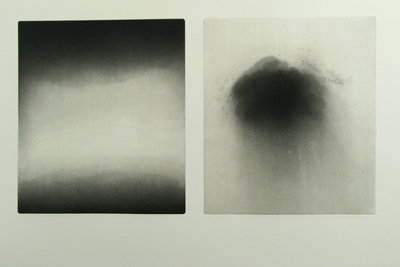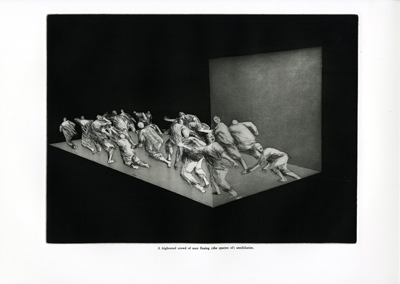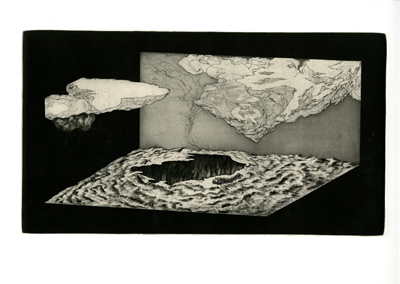I am an artist living and working in Portland, Oregon.
Recently I graduated with my bachelor's in printmaking from Pacific Northwest College Of Art with a strong focus on the intaglio techniques of engraving and aquatint.
My work deals with abstractions of time and history that rule our lives, along with the absurd conditions that people find themselves in.
Other times the act of drawing and physically interacting with the plate create images that satisfy me.
It comes and it goes.
I try not to take serious work too seriously.
When the weather gets warmer and I can no longer be found making prints, it probably means I am in Alaska fishing for salmon on the fishing vessel Shawnee, making a living.
 | |||
| Pursuit - A History, drypoint, liftground and water bite aquatint, 2009. Dimensions: 15,5 x 22 inch. |
Your landscapes are bleak and hostile and your protagonists always seem to be depicted in situations of anguish and fright.
What is your view on the condition of the man that populates your prints?
When I do depict figures, I like dwarfing them by their surroundings.
It is an attempt to activate the impulse of sublime awe in the face of the unknowable.
I suppose the condition of my figures is one of unknowing, and of being in a situation that is outside of their understanding.
This inevitably makes the responses of my figures to their environment primal and unadorned, other considerations being torn away by their exposure to forces greater than themselves and capable of the individuals total consummation/annihilation.
It is an attempt to activate the impulse of sublime awe in the face of the unknowable.
I suppose the condition of my figures is one of unknowing, and of being in a situation that is outside of their understanding.
This inevitably makes the responses of my figures to their environment primal and unadorned, other considerations being torn away by their exposure to forces greater than themselves and capable of the individuals total consummation/annihilation.
Break-up or creation?
Disintegration and re-integration is more how I think of things.
Most of the time I am trying to create a movement within the composition to contrast with the static format of the medium of print.
Movement is key, and without some sort of grand compositional forces I have a tendency to get bored with the image.
Most of the time I am not trying to create "worlds" as such, but attempting to create a composition that operates as a slice of time/space, a cross-section of reality cut adrift from context and greater understanding.
This is most apparent in my series Figurations Of The Inexorable, where that attempt was the fundamental proposition of the series.
It is a strange thing, I think, composing all these 2D images in false (pictorial) space, they come with a whole lot of associations and implications.
Once, when looking at the painting The Coronation Of Napoleon by Jacques-Louis David, I realized that the fundamental idea taken for granted was that just outside of the immaculately constructed scene, the viewer is to believe that what is depicted as happening persists in real space, beyond the frame of the painting, as a real event just the same as any other we experience.
Most of the time I am trying to create a movement within the composition to contrast with the static format of the medium of print.
Movement is key, and without some sort of grand compositional forces I have a tendency to get bored with the image.
Most of the time I am not trying to create "worlds" as such, but attempting to create a composition that operates as a slice of time/space, a cross-section of reality cut adrift from context and greater understanding.
This is most apparent in my series Figurations Of The Inexorable, where that attempt was the fundamental proposition of the series.
It is a strange thing, I think, composing all these 2D images in false (pictorial) space, they come with a whole lot of associations and implications.
Once, when looking at the painting The Coronation Of Napoleon by Jacques-Louis David, I realized that the fundamental idea taken for granted was that just outside of the immaculately constructed scene, the viewer is to believe that what is depicted as happening persists in real space, beyond the frame of the painting, as a real event just the same as any other we experience.
But I realized that this was a lie, that it was not a real scene with real things that persist outside of the rendered space, it was a complete construction built upon this fundamental illusion.
That is not to diminish it: if anything this syndrome of viewership, of believing that rendered pictorial space correlates to real space, is an amazing trick that we play upon ourselves, enriching the whole of viewing for the viewer.
I am just interested in unweaving the rainbow.
So in my work I am constantly considering the role of perception and how we look at flat/pictorial space.
That is not to diminish it: if anything this syndrome of viewership, of believing that rendered pictorial space correlates to real space, is an amazing trick that we play upon ourselves, enriching the whole of viewing for the viewer.
I am just interested in unweaving the rainbow.
So in my work I am constantly considering the role of perception and how we look at flat/pictorial space.
Lately I have been focusing on copperplate engraving and aquatint.
Partly because of engraving's immediacy and the fact that it does not require chemicals, but mostly because nothing quite operates like engraving, there is a directness that demands a huge amount of control that ends up being an arduous joy.
It takes a while and is very unforgiving, but the payoffs can be huge.
That being said, aquatint's ability to create tone, especially when used as spit bite to render ink-wash-style imagery is a striking process that achieves subtly and richness simultaneously.
Recently I have been working on a variation of the spit bite process where an aquatinted plate is bitten with acid through an amount of water, it manages to look like I am printing with smoke.
Partly because of engraving's immediacy and the fact that it does not require chemicals, but mostly because nothing quite operates like engraving, there is a directness that demands a huge amount of control that ends up being an arduous joy.
It takes a while and is very unforgiving, but the payoffs can be huge.
That being said, aquatint's ability to create tone, especially when used as spit bite to render ink-wash-style imagery is a striking process that achieves subtly and richness simultaneously.
Recently I have been working on a variation of the spit bite process where an aquatinted plate is bitten with acid through an amount of water, it manages to look like I am printing with smoke.
When you see a person print an etching for the first time, you are reminded that there is an element of magic to the process.
Not in terms of Chris Angel's Mindfreak or anything like that, just that there is the initial effort (platemaking), there is a moment of chaos where the outcome is uncertain (when the paper is on the plate, going through the press covered to all eyes and undergoing the transformative pressure of the press roller/bed relationship), and then you have the reveal.
What is magical here is the moment where you are required to throw your lot in with chance for that brief moment, where your hard work will either pay off or have been a waste of your life.
And that never changes.
Even now, when I have been working for weeks on a plate and proof it for the first time, I am anxious and my heart is beating as I begin to turn the crank on the press, because I am about to see if I am a success or a failure, or something else.
Not in terms of Chris Angel's Mindfreak or anything like that, just that there is the initial effort (platemaking), there is a moment of chaos where the outcome is uncertain (when the paper is on the plate, going through the press covered to all eyes and undergoing the transformative pressure of the press roller/bed relationship), and then you have the reveal.
What is magical here is the moment where you are required to throw your lot in with chance for that brief moment, where your hard work will either pay off or have been a waste of your life.
And that never changes.
Even now, when I have been working for weeks on a plate and proof it for the first time, I am anxious and my heart is beating as I begin to turn the crank on the press, because I am about to see if I am a success or a failure, or something else.
Lately I have been influenced by physics and the grand conversations going on about cosmology, other dimensions, and the conundrum of empty space.
I am interested in how the abstract influences material reality.
Classically I am very influenced by Albrecht Dürer, Francisco Goya, Max Klinger and Käthe Kollwitz.
Contemporarily I have been following Ernesto Caivano, Julie Mehretu, Paul Pfeifer, and lately Ed Rucha.
I am interested in how the abstract influences material reality.
Classically I am very influenced by Albrecht Dürer, Francisco Goya, Max Klinger and Käthe Kollwitz.
Contemporarily I have been following Ernesto Caivano, Julie Mehretu, Paul Pfeifer, and lately Ed Rucha.
How do you think printing will evolve?
In my first print class when I came to art school, we were asked to give a presentation on three contemporary printmakers.
Everyone in the class was very quickly frustrated/surprised to find that finding a person who one considers a printmaker in the past thirty years was difficult.
There are multitudes of artists who have created prints and many who enjoy printmaking, but few who made prints outside of having most of the labor of printmaking done for them by print shops.
This was a difficult sell on printmaking students who were in the middle of understanding that to be a printmaker is to be both a printer and an artist.
You learn very fast that every aspect of the process effects the quality of the final product, from the polish of the copper plate to the viscosity of the ink, to how the ground is applied, so when you hear that most of the time professional prints are made by artists that create an image and have a body of professionals transfer that into the print process for them, it changes the way you view the work.
Do not get me wrong, I have nothing against the traditional relationship between artist and print shop, it is just a problematic idea by the terms of the contemporary art world and existing as an artist.
Do not get me wrong, I have nothing against the traditional relationship between artist and print shop, it is just a problematic idea by the terms of the contemporary art world and existing as an artist.
I found there was an unspoken question to being a student of printmaking: did you want to be an artist or a printer?
The question is a problematic but important one.
As for the future, much has been made of the digital print, simply because it is new and involves fascinating technology, but its realities seem to be quickly exhausted in terms of having exceptional offerings as a 2D media.
As for the future, much has been made of the digital print, simply because it is new and involves fascinating technology, but its realities seem to be quickly exhausted in terms of having exceptional offerings as a 2D media.
What I am saying is that I do not really see what digital printing as a fine art printmaking medium really brings to the table.
It is a fast way to make a clean image, and a fantastic way to print photography (though its ease of use has effectively destroyed access to older, more beautiful methods of printing photographs), but I do not really see it bringing any new aesthetic possibilities aside from scale and speed.
I believe there will be a return to the hand and an interest in labor as the ability to mechanize art increases.
I believe there will be a return to the hand and an interest in labor as the ability to mechanize art increases.
As the hand disappears from the process, it will become a more and more popular subject of exploration.
This might lead to less people being willing to expend the effort, but the interest to the few will increase.
Also, with the wintry state of the economy and the closing of a number of professional print houses, I believe print will survive within a growing number of professional artists having a direct control over the print process, and fewer artists who have never touched print being called to create them as a purely commercial venture.
The divide between artist and printer will become less and less.
Can you tell us something about your next printmaking project?
I have always wanted to make a book, a hand bound artist book of prints in a narrative format that operates similarly to Lynn Ward's God's Man.
It was a groundbreaking wordless graphic novel done in entirely in wood engravings.
I would want my book to be composed of engraved plates with aquatint, which would take a long time, but would be infinitely satisfying to make, so I have been working on ideas for that, but I have to say I find the burdens of the book format daunting.
Also, I am interested in working with similar engraved imagery on a much larger scale.
Also, I am interested in working with similar engraved imagery on a much larger scale.
Intaglio has always been a relatively small scale medium, as it is very time consuming (especially engraving).
It is hard to deny the power of scale, though, so I am interested to see what happens when I can make a truly huge piece that really exploits the level of detail that engraving can achieve.
 |
Lineform Number 1, engraving, 2010.
Dimensions: 15 x 15 inch. |
 |
The Battle With Matter V, water bite aquatint, 2010.
Dimensions: 22 x 28 inch.
|






2 comments:
Nice post! I live in Portland as well, and will keep an eye out for his work. It's always nice to discover a fellow printmaker.
Thanks
Thanks to you, Drew!
Post a Comment